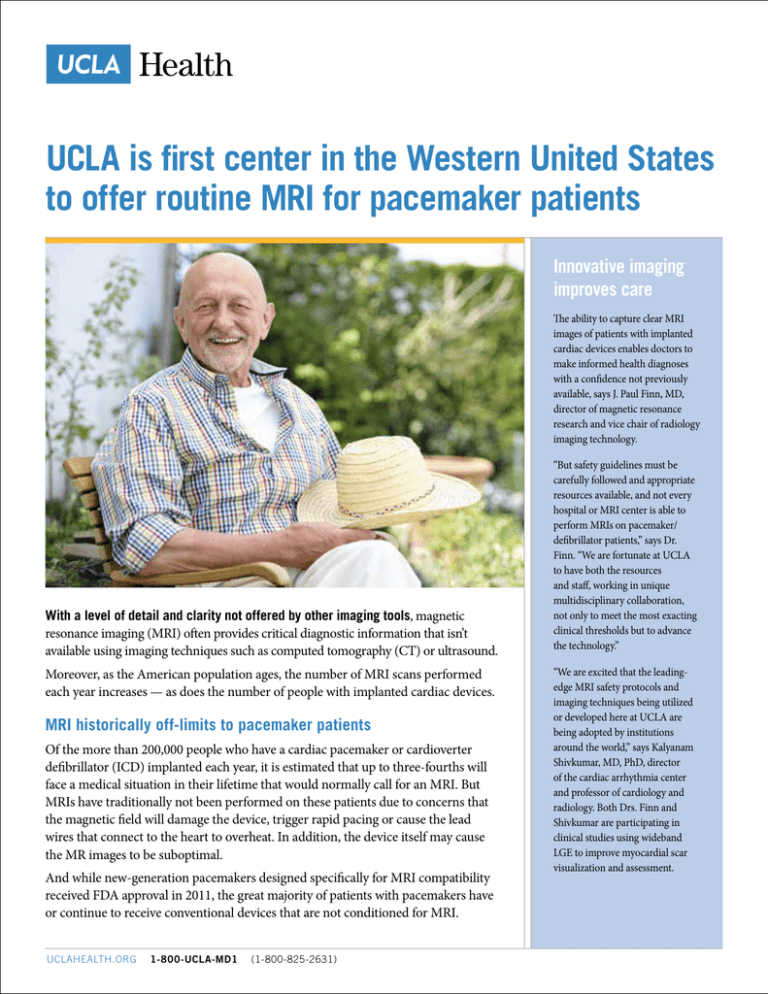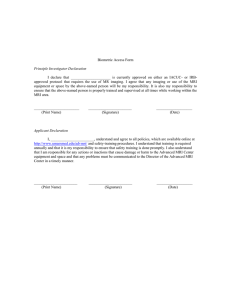UCLA is first center in the Western United States to
advertisement

UCLA is first center in the Western United States to offer routine MRI for pacemaker patients Innovative imaging improves care The ability to capture clear MRI images of patients with implanted cardiac devices enables doctors to make informed health diagnoses with a confidence not previously available, says J. Paul Finn, MD, director of magnetic resonance research and vice chair of radiology imaging technology. With a level of detail and clarity not offered by other imaging tools, magnetic resonance imaging (MRI) often provides critical diagnostic information that isn’t available using imaging techniques such as computed tomography (CT) or ultrasound. Moreover, as the American population ages, the number of MRI scans performed each year increases — as does the number of people with implanted cardiac devices. MRI historically off-limits to pacemaker patients Of the more than 200,000 people who have a cardiac pacemaker or cardioverter defibrillator (ICD) implanted each year, it is estimated that up to three-fourths will face a medical situation in their lifetime that would normally call for an MRI. But MRIs have traditionally not been performed on these patients due to concerns that the magnetic field will damage the device, trigger rapid pacing or cause the lead wires that connect to the heart to overheat. In addition, the device itself may cause the MR images to be suboptimal. And while new-generation pacemakers designed specifically for MRI compatibility received FDA approval in 2011, the great majority of patients with pacemakers have or continue to receive conventional devices that are not conditioned for MRI. UCLAHEALTH.ORG 1-800-UCLA-MD1 (1-800-825-2631) “But safety guidelines must be carefully followed and appropriate resources available, and not every hospital or MRI center is able to perform MRIs on pacemaker/ defibrillator patients,” says Dr. Finn. “We are fortunate at UCLA to have both the resources and staff, working in unique multidisciplinary collaboration, not only to meet the most exacting clinical thresholds but to advance the technology.” “We are excited that the leadingedge MRI safety protocols and imaging techniques being utilized or developed here at UCLA are being adopted by institutions around the world,” says Kalyanam Shivkumar, MD, PhD, director of the cardiac arrhythmia center and professor of cardiology and radiology. Both Drs. Finn and Shivkumar are participating in clinical studies using wideband LGE to improve myocardial scar visualization and assessment. New MRI protocols allow for safe imaging Several large and small studies over the past decade, including the recently completed multi-center MagnaSafe Registry in which UCLA was a participant, have focused on exploring the safety and efficacy of MRI for selected patients with implanted cardiac devices. Evidence, both from our own program and the national study, indicates that in the right clinical setting with an experienced team of cardiovascular MRI specialists, the scan can be performed safely. Patients with these devices who are referred for MRI at UCLA undergo an extensive evaluation of their cardiovascular health and level of device-dependence. The UCLA team follows a protocol based on careful screening of patient eligibility, device selection, programming and monitoring. These parameters include: • Th e implanted device is reprogrammed or turned off prior to the patient entering the scanner to eliminate interference with device function. Participating Physicians J. Paul Finn, MD Director, Magnetic Resonance Research Professor and Vice-Chair, Radiology Imaging Technology Kalyanam Shivkumar, MD, PhD Director, Cardiac Arrhythmia Center Professor of Medicine, Cardiology Noel G. Boyle, MD, PhD Co-Director, Cardiac Arrhythmia Center Professor of Medicine, Cardiology • Th e process is carefully monitored, supervised and interpreted by UCLA Cardiovascular MRI Center radiologists, cardiologists, electrophysiologists and specially trained support staff. • The type and configuration of the leads attached to the device are considered. • Th e correct MR protocol using “wideband LGE” (vide infra) is chosen for each patient. •O nce the MRI is completed, the implanted device is examined and turned on and/or reprogrammed to its original settings. None of the MRI/conventional implanted cardiac device patients at UCLA or in published studies have had a clinically adverse event or have needed to have the device replaced after the scan. A small number of pacemaker patients, such as those with abandoned leads, may still not be able to have MRIs, even with the new protocols. Wideband LGE technique reveals myocardial scarring MRI visualization is the best way to detect myocardial scarring, but the protocol has been especially challenging for cardiac patients with pacemakers or ICDs. Implanted devices can cause hyperintensity (HI) artifacts — bright-white spotting — compromising the image and masking the scar tissue. But in a recent study reported in the journal Heart Rhythm led by Peng Hu, PhD, UCLA assistant professor of radiology, UCLA researchers utilized a unique wideband late gadolinium enhancement (LGE) technique — MRI augmented with a contrasting agent — to dramatically improve scar visualization and assessment. Whereas the metal in the pacemaker or ICD box causes the MRI frequency to drift outside of the useful range with standard LGE technique, “wideband” captures these frequencies, which would otherwise be filtered out. While HI artifacts were present in 16 of 18 patients when using standard MRI, wideband LGE allowed for clear and unobscured interpretation in 15 of 16 patients. Contact Information UCLA Cardiac Arrhythmia Center 100 UCLA Medical Plaza, Suite 690 Los Angeles, CA 90095 (310) 206-2235 for appointments arrhythmia.ucla.edu UCLAHEALTH.ORG 1-800-UCLA-MD1 (1-800-825-2631) 15v3-15:07-15







